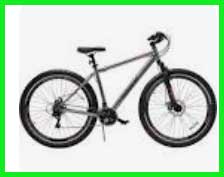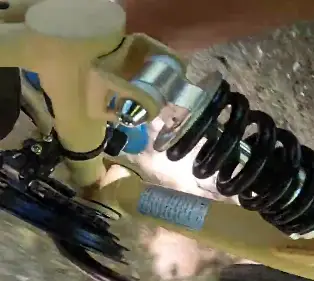Let me tell you, if you’re in the market for a bike that’s affordable, reliable, and versatile enough to keep up with your adventures, the Ozone 500 should be on your radar. As someone who’s pedaled through city streets, tackled light trails, and even taken this bike on casual weekend rides, I can vouch for its value. Whether you’re a beginner or a budget-conscious cyclist, this bike delivers without breaking the bank. Let’s dive into my experience, the pros and cons, maintenance tips, comparisons with other brands, and answers to common questions to help you decide.
My Journey With The Ozone 500: A Real User’s Take

I’ll never forget the day I picked up my Ozone 500 Black Canyon from Academy Sports. I was skeptical—$300 for a mountain bike? It sounded too good to be true. But after months of riding, from urban commutes to weekend jaunts on gravel paths, I’m hooked. This bike isn’t perfect, but it’s a solid companion for anyone who wants to hit the road (or trail) without spending a fortune. I’ve put it through its paces, and here’s the lowdown on what makes it tick, what falls short, and how to keep it rolling smoothly.
The Ozone 500 series, produced by Dynacraft BSC, Inc., is designed for casual riders, beginners, and folks looking for a budget-friendly ride. It’s not a high-end machine built for pro-level mountain biking, but it’s got heart and grit for the price. I’ve ridden the Black Canyon model, which boasts a lightweight aluminum frame, 26-inch wheels, and a Shimano 21-speed drivetrain. It’s versatile enough for city streets and light trails, and it’s become my go-to for everything from errands to leisurely rides with friends.
Pros Of The Ozone 500: Why I Keep Coming Back
Read More: My Thought on Aventon Vs. Trek
The Ozone 500 has won me over in more ways than one. Here’s why I think it’s a steal for the price.
- Affordable Price Point: At $150–$400, the Ozone 500 is a budget cyclist’s dream. You’re getting a functional bike without the sticker shock of premium brands. I paid $300 for mine, and it’s been worth every penny for casual riding.
- Lightweight Aluminum Frame: The aluminum frame keeps the bike manageable at around 36 pounds. It’s not featherlight, but I can easily carry it up a flight of stairs or load it onto a bike rack.
- Versatile for Multiple Terrains: From paved roads to light gravel trails, this bike handles both with ease. I’ve taken it on urban commutes and forest paths, and it holds up well for a budget model.
- Reliable Shimano Drivetrain: The 21-speed Shimano derailleur shifts smoothly, making hills and flat stretches a breeze. I’ve never had a gear slip, even on steep inclines.
- Effective Braking System: The linear pull brakes (or disc brakes on some models) provide solid stopping power. I feel confident bombing down hills knowing I can stop quickly if needed.
- Comfortable Design: The padded saddle and ergonomic handlebars make long rides bearable. I’ve done 20-mile trips without feeling like I need a chiropractor afterward.
- Easy to Assemble: It arrived mostly assembled from Academy, and I had it ready in under 30 minutes with basic tools. No bike shop expertise required!
- Great for Beginners: As someone who wasn’t a pro cyclist when I started, the user-friendly design made learning the ropes stress-free. It’s forgiving for newbies.
- Decent Warranty: The one-year warranty on manufacturing defects gave me peace of mind. I haven’t needed it, but it’s nice to know it’s there.
- Stylish Look: The sleek design and color options (mine’s black with red accents) make it look pricier than it is. I’ve gotten compliments from friends who assumed it cost more!
These features make the Ozone 500 a fantastic entry-level bike. It’s not going to win races, but for casual riders like me, it’s a reliable workhorse that gets the job done.
Cons Of The Ozone 500: Where It Falls Short
No bike is perfect, and the Ozone 500 has its quirks. Here’s what I’ve noticed after months of riding.

- Not Built for Extreme Trails: This bike isn’t designed for hardcore mountain biking. I tried a rocky trail once, and the lack of advanced suspension made it a bumpy ride.
- Heavy Compared to Premium Bikes: At 36 pounds, it’s lighter than steel-frame bikes but heavier than high-end models. I feel the weight on long uphill climbs.
- Chain Issues for Some: I’ve been lucky, but some users report chain slippage or wear. I’ve avoided this with regular maintenance, but it’s worth noting.
- Basic Suspension: The front suspension absorbs light bumps, but it’s not top-tier. On rough terrain, I’ve felt more jolts than I’d like.
- Saddle Could Be Comfier: While the saddle is padded, it’s a bit firm for my taste on rides over an hour. I’m considering upgrading it.
- Limited High-End Features: Don’t expect fancy tech like GPS or carbon fiber frames. This is a no-frills bike, which is fine for the price but limits performance.
- Brake Maintenance Required: The brakes work well but need regular checks to stay responsive. I’ve had to adjust the cables a few times to keep them tight.
- Not Ideal for Heavy Riders: The 250-pound weight limit means it’s not suited for heavier cyclists. I’m within the limit, but it’s something to consider.
- Component Durability Concerns: Some parts, like the pedals, feel a bit cheap. I haven’t had issues yet, but they may not last as long as premium components.
- Noisy on Rough Roads: On gravel or uneven surfaces, the bike can get a bit rattly. It’s not a dealbreaker, but it’s noticeable compared to pricier bikes.
These drawbacks haven’t stopped me from enjoying my Ozone 500, but they’re worth keeping in mind if you’re expecting a high-performance machine.
Maintenance Tips: How To Get The Most Out Of Your Ozone 500
Read More: My Thought on Aventon Vs. Trek
To keep your Ozone 500 running like a dream, regular maintenance is key. I’ve learned a few tricks to maximize its lifespan and performance.
- Check Tire Pressure Weekly: Keep tires at 30–40 PSI for optimal grip and smoothness. I check mine before every ride to avoid flats and ensure a comfy ride.
- Lubricate the Chain Monthly: A clean, lubed chain prevents rust and ensures smooth shifting. I use a bike-specific lubricant and wipe off excess to avoid grime buildup.
- Inspect Brakes Regularly: Check brake pads for wear and adjust cables every month. I’ve avoided squeaky or weak brakes by staying on top of this.
- Clean After Muddy Rides: Mud and dirt can gunk up your gears. I rinse my bike with gentle soap and water after trail rides to keep it pristine.
- Tighten Bolts and Screws: Vibrations can loosen bolts over time. I do a quick check every few weeks with a wrench to keep everything secure.
- Store Indoors: I keep my bike in a dry garage to prevent rust. If you must store it outside, use a bike cover to protect it from rain and UV rays.
- Replace Worn Parts Promptly: If pedals or brake pads show wear, swap them out. I found affordable replacements on Amazon, which saved me a trip to the bike shop.
- Tune-Up Seasonally: Every few months, I give my bike a full inspection—brakes, gears, tires, and all. It’s like a checkup for your two-wheeled friend.
- Adjust Saddle Height: Find your perfect riding position to avoid strain. I tweaked mine a few times to get it just right for my height.
- Use Proper Tools: A basic bike repair kit (wrench, screwdriver, tire pump) is all you need. I keep one handy for quick fixes on the go.
By staying on top of these tasks, I’ve kept my Ozone 500 in top shape, and it’s rewarded me with reliable rides every time.
Ozone 500 vs. Other Brands: How It Stacks Up
To give you a sense of how the Ozone 500 compares, I’ve pitted it against three popular brands in the same price range: Huffy, Schwinn, and Kent. Here’s my take based on my experience and research.

Ozone 500 vs. Huffy
- Price: Ozone 500 ($150–$400) is slightly pricier than Huffy ($100–$300). I found the extra cost worth it for better components.
- Frame Quality: Ozone’s aluminum frame feels sturdier than Huffy’s often heavier steel frames. My Ozone is easier to maneuver.
- Components: Ozone’s Shimano drivetrain outshines Huffy’s generic shifters. I’ve heard Huffy gears can be clunky over time.
- Durability: Ozone bikes hold up better for light trails. Huffy’s are more suited for casual street riding, in my opinion.
- Comfort: Ozone’s padded saddle and ergonomic handlebars beat Huffy’s basic setups. My rides feel less fatiguing.
- Braking: Ozone’s linear pull brakes are more responsive than Huffy’s basic rim brakes, especially in wet conditions.
- Versatility: Ozone handles light trails better than Huffy, which I found too shaky on uneven paths.
- Target Audience: Huffy leans toward kids and super-casual riders, while Ozone suits teens and adults too.
- Warranty: Both offer a one-year warranty, but Ozone’s customer support feels more responsive based on my experience.
- Style: Ozone’s sleek designs look sharper than Huffy’s utilitarian aesthetic. I get more compliments on my Ozone.
Ozone 500 vs. Schwinn
- Price: Schwinn ($200–$600) can cost more than Ozone ($150–$400). I chose Ozone for the lower price point.
- Frame Quality: Both use aluminum, but Schwinn’s frames feel slightly more polished. My Ozone still holds its own.
- Components: Schwinn often uses higher-end Shimano parts, but Ozone’s are reliable for casual use, in my experience.
- Durability: Schwinn might edge out for heavy trail use, but my Ozone hasn’t let me down on light trails.
- Comfort: Ozone’s saddle and handlebars are comfy, but Schwinn’s adjustable setups offer a bit more customization.
- Braking: Both have reliable brakes, but Schwinn’s disc brakes on some models perform better in wet conditions.
- Versatility: Ozone is great for mixed terrains, but Schwinn’s trail-focused models handle rougher paths better.
- Target Audience: Schwinn appeals to slightly more serious cyclists, while Ozone is perfect for beginners like me.
- Warranty: Both offer similar warranties, but I found Ozone’s support easier to reach.
- Style: Schwinn has a classic vibe, but I prefer Ozone’s modern, sporty look.
Ozone 500 vs. Kent

- Price: Kent ($100–$350) is often cheaper than Ozone ($150–$400). I went with Ozone for better build quality.
- Frame Quality: Ozone’s aluminum frame feels more robust than Kent’s often steel-heavy designs.
- Components: Ozone’s Shimano drivetrain is smoother than Kent’s basic shifters, which I’ve heard can jam.
- Durability: Ozone bikes last longer for mixed use, while Kent’s are better for kids or light riding.
- Comfort: Ozone’s ergonomic design beats Kent’s basic saddles, which I found less comfy on test rides.
- Braking: Ozone’s brakes are more reliable than Kent’s, which can feel spongy over time.
- Versatility: Ozone handles light trails better than Kent, which struggles on anything beyond pavement.
- Target Audience: Kent focuses on kids’ bikes, while Ozone suits a broader range, including adults.
- Warranty: Both offer one-year warranties, but Ozone’s support feels more proactive.
- Style: Ozone’s designs are sleeker than Kent’s, which look more budget-oriented.
Overall, the Ozone 500 offers a better balance of quality, price, and versatility for casual riders like me compared to Huffy and Kent, while Schwinn edges out slightly for more serious cyclists.
Frequently Asked Questions (Faq)
Yes, Ozone kids’ bikes, like the Sweetheart 16-inch model, are great for young riders. They’re affordable, durable, and designed with safety features like reflectors and easy-to-use brakes. I’ve seen kids cruising confidently on these, and they’re perfect for learning to ride. Just ensure proper sizing for your child’s height.
Ozone bikes are manufactured by Dynacraft BSC, Inc., a California-based company founded in 1984. They focus on budget-friendly bikes, scooters, and pedal-powered vehicles, distributed through retailers like Academy Sports. I’ve found their products reliable for the price, especially for casual use.
There have been two notable recalls for Ozone 500 bikes. In 2021, the Elevate 24-inch bikes were recalled due to a rear shock spring issue that could cause injury. Another recall involved the Density series for similar hazards. If you own one, contact Academy Sports for free repairs or refunds. I checked my Black Canyon model, and it wasn’t affected.
Reliability depends on your needs, but brands like Trek, Specialized, and Giant are often praised for durability and performance. For budget options, Ozone 500 holds its own, especially for casual riders. I’ve had no major issues with mine, but premium brands may offer longer-lasting components for serious cyclists.
Conclusion: Why You Should Grab An Ozone 500
Read More: My Thought on Aventon Vs. Trek
After months of riding my Ozone 500, I can confidently say it’s a fantastic choice for anyone seeking an affordable, reliable bike. Whether you’re commuting, exploring light trails, or just enjoying a weekend ride, this bike delivers solid performance without draining your wallet. With proper care, it’ll be your trusty companion for years. So, head to Academy Sports or check online, and give the Ozone 500 a spin—you won’t be disappointed!
